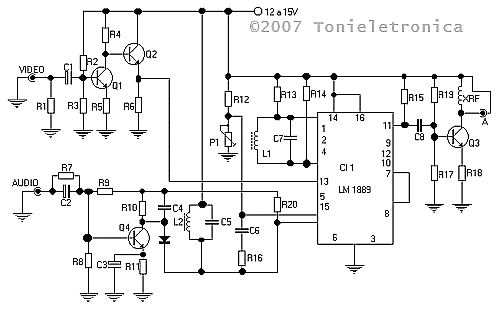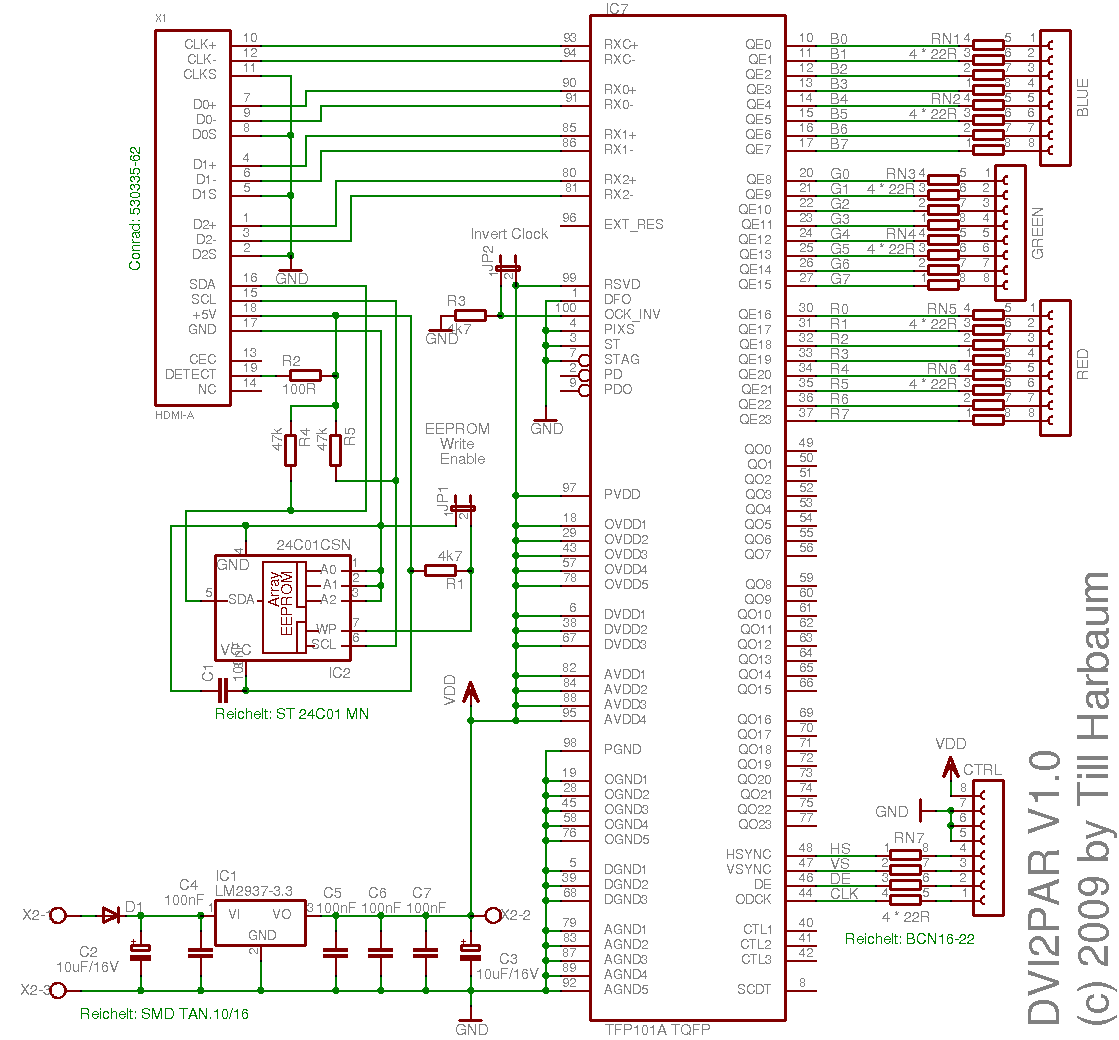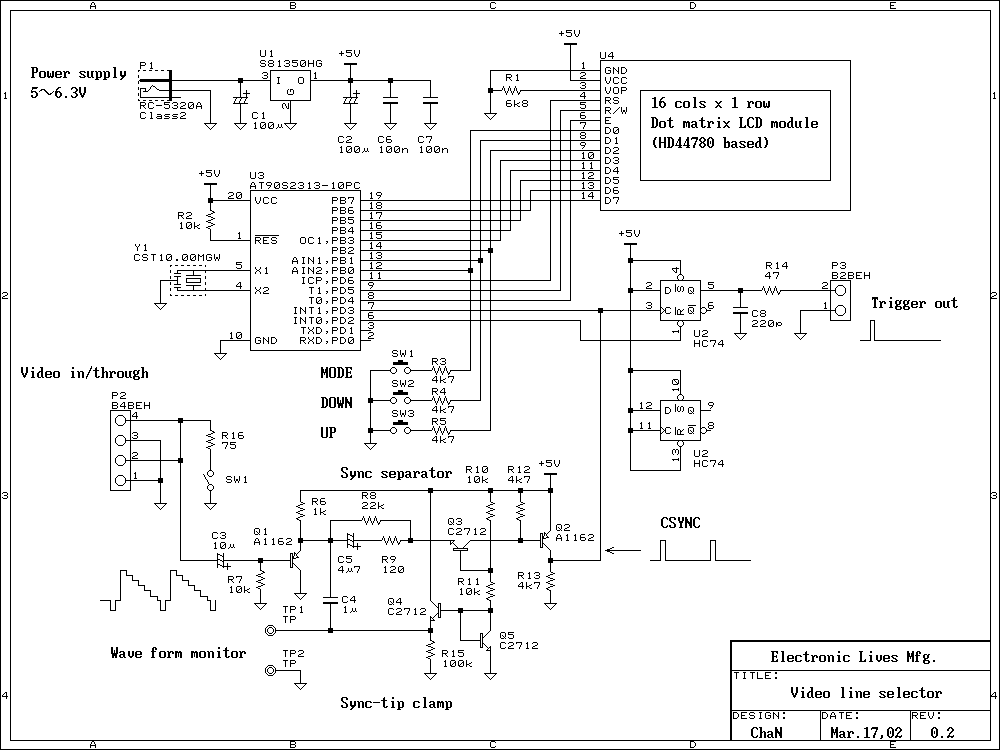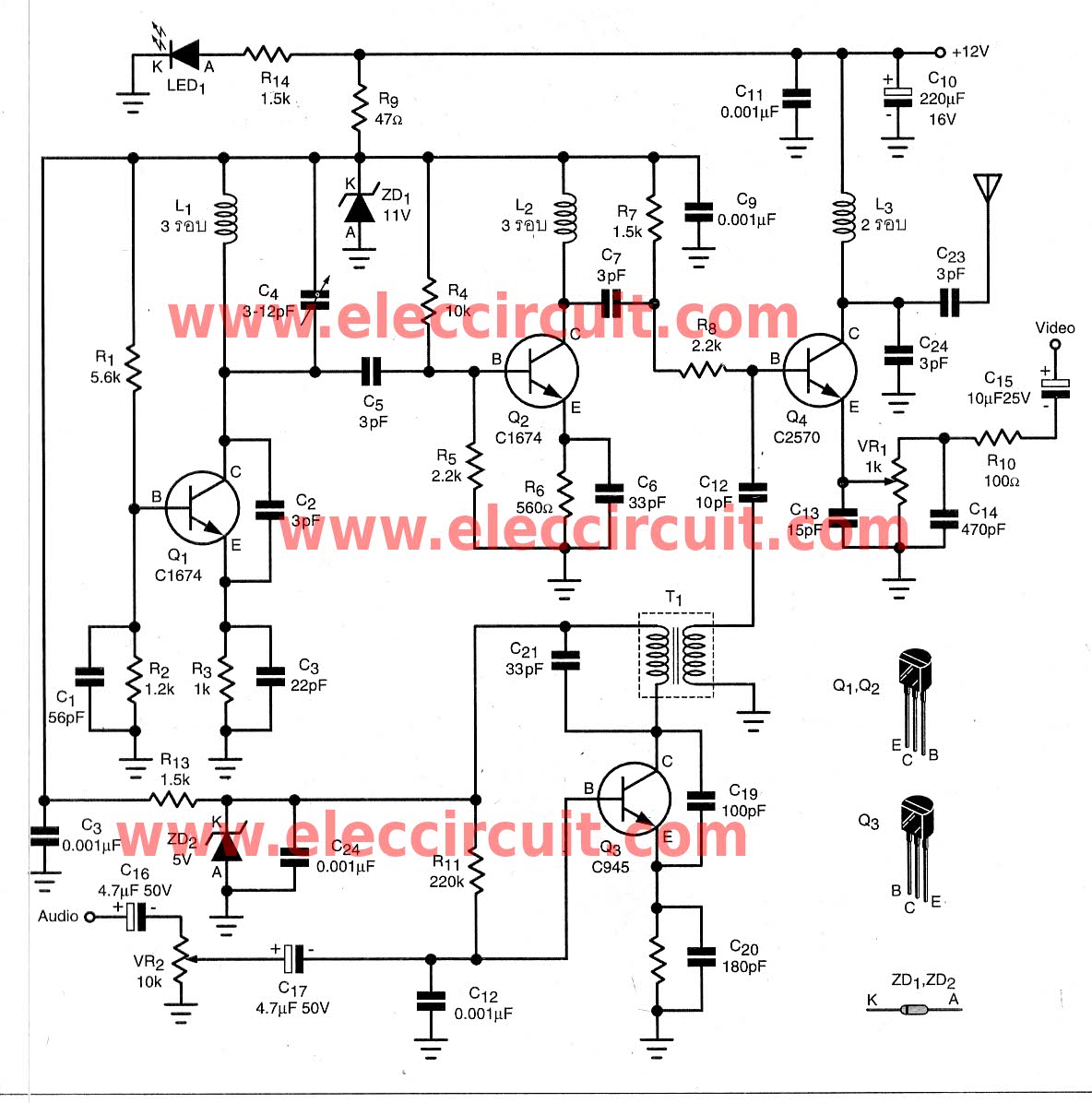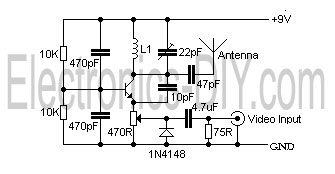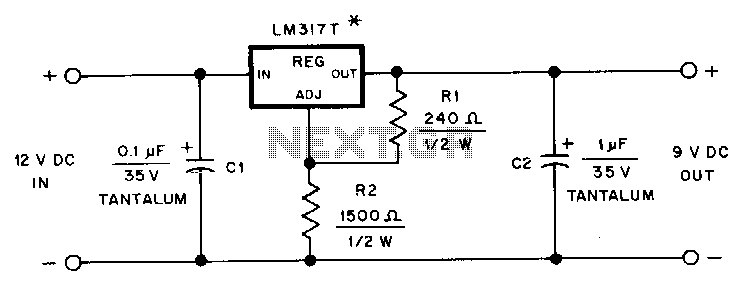
Video monitor adapter enhances oscilloscope
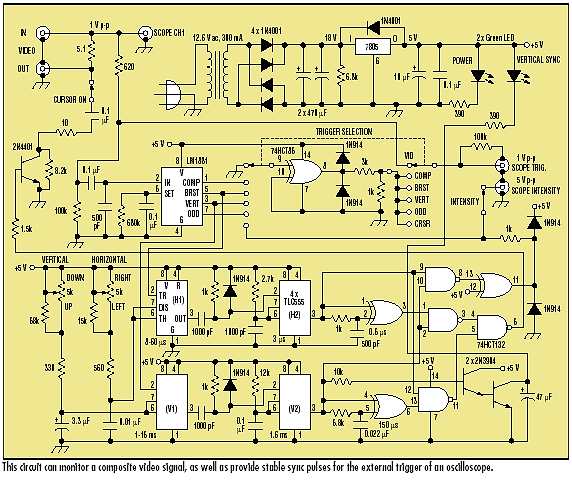
Video signals can be challenging to display on an oscilloscope. Standard trigger circuits in most oscilloscopes often struggle to achieve a stable trigger from the combined vertical and horizontal sync signals, color burst, and picture signal found in a composite video waveform. Even the TV Sync trigger detector available in some low-cost oscilloscopes is insufficient for obtaining a stable display. The circuit illustrated monitors a composite video signal and generates stable sync pulses for the external trigger of an oscilloscope. The Trigger Selector switch allows for the selection of Video, Composite Sync, Color Burst Sync, Vertical Sync, Vertical Odd Field Sync, or Cursor Position for the oscilloscope. Two timer chains produce a rectangular cursor, with a width and height approximately 8% of the full screen, which can be moved across the entire width and height of the screen by adjusting the Horizontal and Vertical Cursor Controls. The circuit also provides a positive Intensity pulse for the oscilloscope's Intensity (Z-axis) input, enabling detailed inspection of any portion of the video signal corresponding to the cursor's position. When the oscilloscope is connected to a color demodulator functioning as a vectorscope, this feature highlights the demodulated color on the vectorscope display, which is beneficial for color correction or enhancement in video editing setups. The circuit includes a Power LED and a Vertical Sync Indicator LED. The Cursor On switch allows the movable cursor to be displayed on a video monitor connected to the Video Out connector. The Intensity switch regulates the Intensity pulse sent to the oscilloscope. The LM1881 Sync Detector is responsible for separating the various sync signals from the composite video into stable logic pulses. Color burst sync, which occurs at the beginning of each horizontal line, is sent to a 555 CMOS timer, with the timer's output pulse width adjustable by the Horizontal Cursor Control across the full width of the line. This output pulse drives a second 555 timer that determines the cursor window width. The output from this second timer is fed into a 74HCT86 exclusive-OR gate through an RC circuit, generating a brief positive pulse corresponding to the start and end of the horizontal cursor window. Vertical sync, which occurs at the beginning of each vertical field, is processed by a parallel set of timer circuits to define the start and end of the vertical cursor window. The 74HCT132 NAND gates combine these signals to create the desired square cursor. The resulting square cursor controls a 2N4401 transistor, which, when activated, reduces the amplitude of the video signal at the Video Out connector through the voltage-divider action of the 5.1 kΩ and 10 kΩ resistors. This results in a gray cursor surrounding the area of interest on a video monitor. A 0.1 µF capacitor protects the transistor from any DC voltage present on the video signal. The fixed resistors associated with the Horizontal and Vertical Cursor Controls provide a range of timing adjustments, and their values can be modified to accommodate the tolerances of other components.
The circuit design effectively addresses the challenges associated with displaying video signals on oscilloscopes by utilizing a combination of sync detection and timing mechanisms. The LM1881 Sync Detector plays a crucial role in isolating the sync pulses necessary for accurate triggering, ensuring that the oscilloscope can maintain a stable display even when faced with the complexities of composite video signals. The dual timer configuration, utilizing 555 timers, allows for precise control over the dimensions and positioning of the cursor, providing users with the flexibility to inspect specific areas of the video signal in detail.
The integration of the 74HCT86 exclusive-OR gate and the 74HCT132 NAND gates further enhances the functionality of the circuit, allowing for the creation of a well-defined square cursor that can be easily manipulated across the display. The use of transistors for signal modulation ensures that the video output is not only visually informative but also maintains the integrity of the original signal. The design's consideration for component tolerances and the inclusion of protective elements, such as the capacitor, reflects a thorough understanding of the practical challenges encountered in electronic circuit design. Overall, this circuit serves as an invaluable tool for professionals engaged in video signal analysis and editing, facilitating enhanced precision and control in oscilloscope applications.Video signals can be difficult to display on an oscilloscope. Normal trigger circuits in most oscilloscopes have trouble getting a stable trigger from the combined vertical and horizontal sync signals, color burst, and picture signal in a composite video waveform. Even the TV Sync trigger detector available in some low-cost oscilloscopes is inadequate to obtain a
stable display. The circuit shown monitors a composite video signal and provides stable sync pulses for the external trigger of an oscilloscope (see the figure). The Trigger Selector switch chooses Video, Composite Sync, Color Burst Sync, Vertical Sync, Vertical Odd Field Sync, or Cursor Position for the oscilloscope.
Two timer chains provide a rectangular cursor (width and height approximately 8% of the full screen). The cursor is movable across the full width and height of the screen by adjusting the Horizontal and Vertical Cursor Controls.
The circuit provides a positive Intensity pulse for the oscilloscope Intensity (Z-axis) input. This permits close inspection of any portion of the video signal corresponding to the position of the cursor. If the oscilloscope is hooked up to a color demodulator as a vectorscope, this feature highlights the demodulated color on the vectorscope display.
This is useful in applying color correction or enhancement as part of a video-editing setup. The circuit contains a Power LED and a Vertical Sync Indicator LED. The Cursor On switch allows the movable cursor to be observed on a video monitor attached to the Video Out connector. The Intensity switch controls the Intensity pulse to the oscilloscope. The LM1881 Sync Detector separates the various sync signals from the composite video into stable logic pulses.
Color burst sync, which occurs at the start of every horizontal line, is applied to a 555 CMOS timer. The timer output pulse width is adjusted by the Horizontal Cursor Control over the full width of the line.
This output pulse drives a second 555 timer which establishes the cursor window width. The output of this second timer drives a 74HCT86 exclusive-OR gate through an RC circuit, providing a short positive pulse corresponding to the start and end of the horizontal cursor window. Vertical sync, which occurs at the start of every vertical field, is similarly processed by a parallel set of timer circuits to establish the start and end of the vertical cursor window.
The 74HCT132 NAND gates combine these signals into the desired square cursor. The resulting square cursor drives the 2N4401 transistor. When switched on, the transistor reduces the amplitude of the video signal at the Video Out connector through the voltage-divider action of the 5. 1- © and 10- © resistors. This results in a gray cursor surrounding the area of interest on a video monitor. The 0. 1- µF capacitor protects the transistor from any dc voltage on the video. The fixed resistors associated with the Horizontal and Vertical Cursor Controls provide the range of timing adjustments shown.
Their values may be modified to account for tolerances of the other components. 🔗 External reference
The circuit design effectively addresses the challenges associated with displaying video signals on oscilloscopes by utilizing a combination of sync detection and timing mechanisms. The LM1881 Sync Detector plays a crucial role in isolating the sync pulses necessary for accurate triggering, ensuring that the oscilloscope can maintain a stable display even when faced with the complexities of composite video signals. The dual timer configuration, utilizing 555 timers, allows for precise control over the dimensions and positioning of the cursor, providing users with the flexibility to inspect specific areas of the video signal in detail.
The integration of the 74HCT86 exclusive-OR gate and the 74HCT132 NAND gates further enhances the functionality of the circuit, allowing for the creation of a well-defined square cursor that can be easily manipulated across the display. The use of transistors for signal modulation ensures that the video output is not only visually informative but also maintains the integrity of the original signal. The design's consideration for component tolerances and the inclusion of protective elements, such as the capacitor, reflects a thorough understanding of the practical challenges encountered in electronic circuit design. Overall, this circuit serves as an invaluable tool for professionals engaged in video signal analysis and editing, facilitating enhanced precision and control in oscilloscope applications.Video signals can be difficult to display on an oscilloscope. Normal trigger circuits in most oscilloscopes have trouble getting a stable trigger from the combined vertical and horizontal sync signals, color burst, and picture signal in a composite video waveform. Even the TV Sync trigger detector available in some low-cost oscilloscopes is inadequate to obtain a
stable display. The circuit shown monitors a composite video signal and provides stable sync pulses for the external trigger of an oscilloscope (see the figure). The Trigger Selector switch chooses Video, Composite Sync, Color Burst Sync, Vertical Sync, Vertical Odd Field Sync, or Cursor Position for the oscilloscope.
Two timer chains provide a rectangular cursor (width and height approximately 8% of the full screen). The cursor is movable across the full width and height of the screen by adjusting the Horizontal and Vertical Cursor Controls.
The circuit provides a positive Intensity pulse for the oscilloscope Intensity (Z-axis) input. This permits close inspection of any portion of the video signal corresponding to the position of the cursor. If the oscilloscope is hooked up to a color demodulator as a vectorscope, this feature highlights the demodulated color on the vectorscope display.
This is useful in applying color correction or enhancement as part of a video-editing setup. The circuit contains a Power LED and a Vertical Sync Indicator LED. The Cursor On switch allows the movable cursor to be observed on a video monitor attached to the Video Out connector. The Intensity switch controls the Intensity pulse to the oscilloscope. The LM1881 Sync Detector separates the various sync signals from the composite video into stable logic pulses.
Color burst sync, which occurs at the start of every horizontal line, is applied to a 555 CMOS timer. The timer output pulse width is adjusted by the Horizontal Cursor Control over the full width of the line.
This output pulse drives a second 555 timer which establishes the cursor window width. The output of this second timer drives a 74HCT86 exclusive-OR gate through an RC circuit, providing a short positive pulse corresponding to the start and end of the horizontal cursor window. Vertical sync, which occurs at the start of every vertical field, is similarly processed by a parallel set of timer circuits to establish the start and end of the vertical cursor window.
The 74HCT132 NAND gates combine these signals into the desired square cursor. The resulting square cursor drives the 2N4401 transistor. When switched on, the transistor reduces the amplitude of the video signal at the Video Out connector through the voltage-divider action of the 5. 1- © and 10- © resistors. This results in a gray cursor surrounding the area of interest on a video monitor. The 0. 1- µF capacitor protects the transistor from any dc voltage on the video. The fixed resistors associated with the Horizontal and Vertical Cursor Controls provide the range of timing adjustments shown.
Their values may be modified to account for tolerances of the other components. 🔗 External reference
